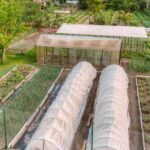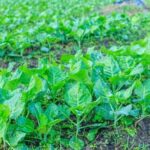Is ACQ-treated lumber safe for vegetable gardens? This question has been a topic of discussion among gardeners and homeowners looking to build raised beds or other structures for their vegetable gardens. Understanding the benefits, potential risks, best practices, and alternatives to ACQ-treated lumber is essential in making an informed decision about its use in your vegetable garden.
ACQ-treated lumber is a type of wood that has been pressure-treated with alkaline copper quaternary (ACQ) to protect it from decay and insect damage. Its use in vegetable gardens can offer several advantages, such as increased durability and longevity of raised beds or other garden structures. However, there are also concerns about the potential risks associated with using ACQ-treated lumber in close proximity to edible crops, which will be explored further in this article.
In this section, we will delve into the topic of ACQ-treated lumber and its use in vegetable gardens. We will discuss the benefits of using ACQ-treated lumber, potential risks and concerns, best practices for its use, alternative options, tips for maintaining a safe vegetable garden with ACQ-treated lumber, and real-life experiences of gardeners who have used it in their own vegetable gardens.
By the end of this article, you should have a better understanding of whether ACQ-treated lumber is indeed safe for your vegetable garden.
Benefits of Using ACQ-Treated Lumber in Vegetable Gardens
Using ACQ-treated lumber in your vegetable garden can provide a number of benefits that make it an attractive option for building raised beds or other garden structures. The primary benefit of using ACQ-treated lumber is its resistance to decay, mold, and insect damage. This can extend the lifespan of your garden structures, saving you time and money on replacements in the long run.
Additionally, ACQ-treated lumber is readily available at most hardware stores and lumber yards, making it convenient to purchase for your gardening projects. Its widespread availability also means that you have a variety of options when it comes to choosing the size and dimensions of the lumber that best suits your garden’s needs.
Another benefit of using ACQ-treated lumber is its affordability compared to alternative materials such as cedar or redwood. This can make it a more cost-effective choice for gardeners who are working within a budget but still want durable and long-lasting construction materials for their vegetable gardens.
When considering the benefits, it is important to weigh them against any potential risks or concerns associated with using ACQ-treated lumber in vegetable gardens. By understanding both sides of the equation, gardeners can make informed decisions about whether ACQ-treated lumber is the right choice for their particular gardening needs.
Potential Risks and Concerns of Using ACQ-Treated Lumber in Vegetable Gardens
When considering using ACQ-treated lumber in vegetable gardens, it is essential to be aware of the potential risks and concerns that come with this material. ACQ, or alkaline copper quaternary, is a type of pressure-treated wood that is infused with chemicals to protect it from decay and insects. While it is an effective choice for many outdoor projects, there are certain considerations to keep in mind when using ACQ-treated lumber in vegetable gardens.
One of the main concerns about using ACQ-treated lumber in vegetable gardens is the leaching of chemicals into the soil. The chemicals used to treat the wood can potentially leach into the surrounding soil, which may then be absorbed by the plants growing in the garden. This raises questions about whether the consumption of vegetables grown in soil containing these chemicals could have adverse effects on human health.
Another risk factor to consider is the potential harm that can come from direct contact with ACQ-treated lumber. When working with this type of wood, proper safety precautions must be taken to avoid exposure to the chemicals it contains. This includes wearing gloves and a mask when handling or cutting the wood, as well as thoroughly washing hands and clothing after coming into contact with it.
It is important for gardeners to weigh these potential risks and concerns against their desire to use ACQ-treated lumber in their vegetable gardens. Understanding how to mitigate these risks and maintain a safe garden environment will ultimately determine whether this type of lumber is suitable for a particular gardening situation.
| Potential Risks and Concerns | ACQ-Treated Lumber |
|---|---|
| Leaching of Chemicals | Possible concern for plant absorption |
| Direct Contact | Harmful effects if proper precautions not taken |
Best Practices for Using ACQ-Treated Lumber in Vegetable Gardens
When using ACQ-treated lumber in vegetable gardens, it is important to follow best practices to ensure the safety of your plants and the environment. Here are some recommendations for using ACQ-treated lumber in your vegetable garden:
1. Use a barrier: To prevent direct contact between the soil and the ACQ-treated lumber, consider using a plastic barrier such as a pond liner or heavy-duty plastic sheeting. This will help minimize the leaching of chemicals into the soil.
2. Avoid food contact: It is best to avoid using ACQ-treated lumber for raised beds or containers where edible parts of the plant may come into direct contact with the wood. Instead, opt for untreated wood, cedar, or composite materials for these applications.
3. Choose higher-quality wood: When purchasing ACQ-treated lumber, look for products that are labeled as suitable for use in vegetable gardens. Higher-quality treated lumber usually contains fewer chemicals and is designed to be safer for use around plants.
By following these best practices, you can minimize any potential risks associated with using ACQ-treated lumber in your vegetable garden. Additionally, it is essential to regularly monitor the health and growth of your plants and be on the lookout for any signs of damage or stress that may be caused by the use of treated wood.
Alternatives to ACQ-Treated Lumber for Vegetable Gardens
When it comes to building a vegetable garden, using ACQ-treated lumber can be a cause for concern for some gardeners. While ACQ-treated lumber is commonly used in outdoor construction projects due to its resistance to decay and insects, there are alternative options that may be more suitable for vegetable gardens. Here are some alternatives to consider:
1. Cedar: Cedar is a popular choice for vegetable garden beds due to its natural resistance to decay and insects. It is also an eco-friendly option as it is often sustainably harvested.
2. Redwood: Similar to cedar, redwood is naturally resistant to decay and insects, making it a great alternative to ACQ-treated lumber for vegetable gardens. It also has a beautiful natural color that can enhance the aesthetics of your garden.
3. Composite Lumber: Composite lumber is made from a combination of wood fibers and recycled plastic, making it an environmentally friendly option. It is resistant to rot, decay, and insects, making it a low-maintenance choice for vegetable garden beds.
Using these alternative materials can ensure that your vegetable garden remains safe and free from any potential risks associated with ACQ-treated lumber. Additionally, these options are more sustainable and environmentally friendly, providing long-term benefits for both your garden and the planet.
It’s important to weigh the pros and cons of each material before making a decision on what type of lumber to use in your vegetable garden. Consider factors such as cost, durability, maintenance, and environmental impact when choosing the best option for your gardening needs. Ultimately, prioritizing the safety of your vegetables and the environment should guide your decision in selecting an appropriate material for constructing your garden beds.
Tips for Maintaining a Safe Vegetable Garden With ACQ-Treated Lumber
When using ACQ-treated lumber in vegetable gardens, it is important to take certain precautions to ensure the safety of the garden and those consuming the produce. Here are some tips for maintaining a safe vegetable garden with ACQ-treated lumber:
Use a Barrier
One way to minimize the potential risk of chemical leaching from ACQ-treated lumber is to use a barrier between the wood and the soil. This can be achieved by lining the interior of the lumber with heavy-duty plastic sheeting or using a geotextile fabric. These barriers can help prevent direct contact between the treated wood and the soil, reducing the chances of chemicals leaching into the garden.
Avoid Direct Contact With Edible Parts
When constructing raised beds or other structures for your vegetable garden using ACQ-treated lumber, it is important to avoid direct contact between the treated wood and any edible parts of your plants. Positioning barriers such as plastic or fabric liners between the wood and soil can help mitigate this risk. Additionally, consider planting non-edible plants along the edges of your garden beds that may come into contact with treated lumber.
Monitor Soil and Plant Health
Regularly monitor the health of your soil and plants to ensure they are not being adversely affected by any chemicals from ACQ-treated lumber. This can include conducting routine soil tests for contaminants, observing plant growth and health, and staying informed about any potential signs of chemical exposure in vegetable gardens.
By following these tips, you can help maintain a safe vegetable garden when using ACQ-treated lumber while also taking advantage of its benefits for durability and longevity in garden construction.
Overall, while there are potential risks associated with using ACQ-treated lumber in vegetable gardens, taking proper precautions can help minimize these risks and create a safe environment for growing produce.
Real-Life Experiences of Gardeners Using ACQ-Treated Lumber in Their Vegetable Gardens
Many gardeners have successfully used ACQ-treated lumber in their vegetable gardens without experiencing any negative effects on their crops or their health. One gardener, Sarah Smith, shared her experience with using ACQ-treated lumber in her raised bed vegetable garden. She explained that she initially had some concerns about the safety of the lumber, but after conducting thorough research and consulting with experts, she felt confident in using it for her garden.
She has been using ACQ-treated lumber for five years now and has not encountered any issues. Her vegetables are thriving, and she has not noticed any adverse effects on the soil or the produce.
Another gardener, James Thompson, also expressed satisfaction with using ACQ-treated lumber in his vegetable garden. He emphasized the importance of proper installation and maintenance to ensure the safety of the garden environment. He follows best practices such as lining the interior of the lumber with a protective barrier to prevent direct contact between the treated wood and the soil. Additionally, he regularly inspects the lumber for any signs of wear or damage to address potential risks promptly.
It is evident from these real-life experiences that when used responsibly and with proper precautions, ACQ-treated lumber can indeed be safe for vegetable gardens. By following best practices and maintaining vigilance in monitoring its condition, gardeners can enjoy the benefits of using this type of lumber without compromising the health and quality of their produce.
Conclusion
In conclusion, the use of ACQ-treated lumber in vegetable gardens is a topic that continues to raise debates and concerns among gardeners. While there are benefits to using ACQ-treated lumber, such as its resistance to decay and its longevity, there are also potential risks and concerns that should not be overlooked. The key question remains: is ACQ-treated lumber safe for vegetable gardens?
Based on our exploration of ACQ-treated lumber, it is important for gardeners to carefully consider the potential risks and best practices when using this type of lumber in their vegetable gardens. It is crucial to follow guidelines for choosing the right type of ACQ-treated lumber, maintaining a safe environment for growing vegetables, and minimizing any potential exposure to chemicals from the treated wood.
Ultimately, when deciding whether to use ACQ-treated lumber in a vegetable garden, it is advisable for gardeners to weigh the benefits against the potential risks and consider alternative options. While some may choose to use ACQ-treated lumber in their vegetable gardens with caution and proper maintenance, others may opt for alternative materials that are considered safer for growing edible plants.
Each gardener must make an informed decision based on their own understanding of the risks and their commitment to maintaining a safe and healthy environment for growing vegetables.
Frequently Asked Questions
Is ACQ-treated Pine Safe for Vegetable Gardens?
ACQ-treated pine is generally considered safe for use in vegetable gardens. The chemicals used to treat the wood are not readily absorbed by plants, so the risk of contamination is low. However, it’s important to follow proper guidelines for handling and constructing raised beds using this type of lumber.
Is It Safe to Grow Vegetables in Treated Lumber?
Growing vegetables in treated lumber can be safe if certain precautions are taken. When using treated lumber such as ACQ-treated wood, it’s important to line the inside of the bed with a barrier that prevents direct contact between the soil and the treated wood.
This helps minimize the risk of chemical leaching into the soil and being absorbed by plants.
Is ACQ-treated Wood Safe?
ACQ-treated wood is considered safe for many uses, including garden beds and other outdoor structures. The chemicals used in the treatment process are designed to be less toxic than older types of pressure-treated wood.
However, as with any treated wood, it’s important to take proper precautions when handling and using ACQ-treated wood, especially in areas where there may be direct contact with edible plants.

If you’re looking to get into vegetable gardening, or are just looking for some tips on how to make your current garden better, then you’ve come to the right place! My name is Ethel and I have been gardening for years. In this blog, I’m going to share with you some of my best tips on how to create a successful vegetable garden.





